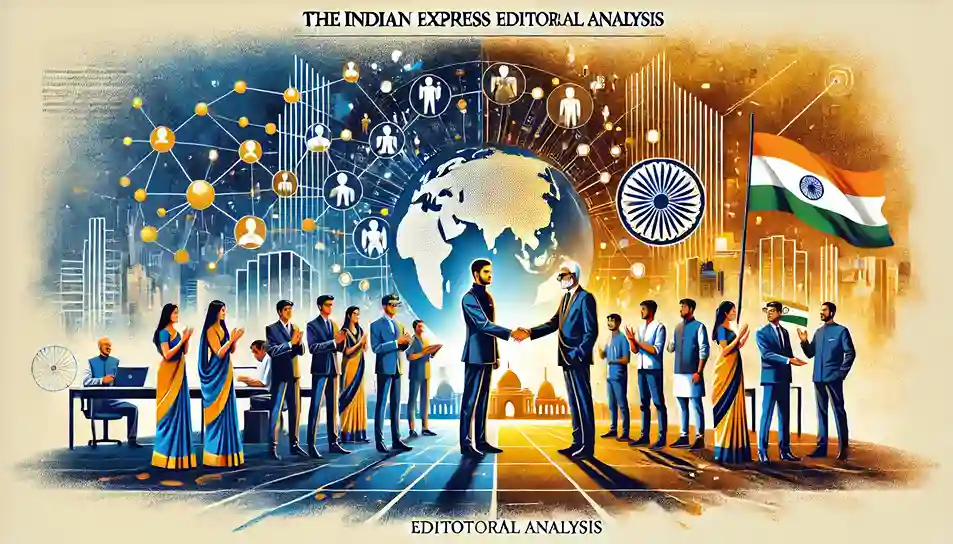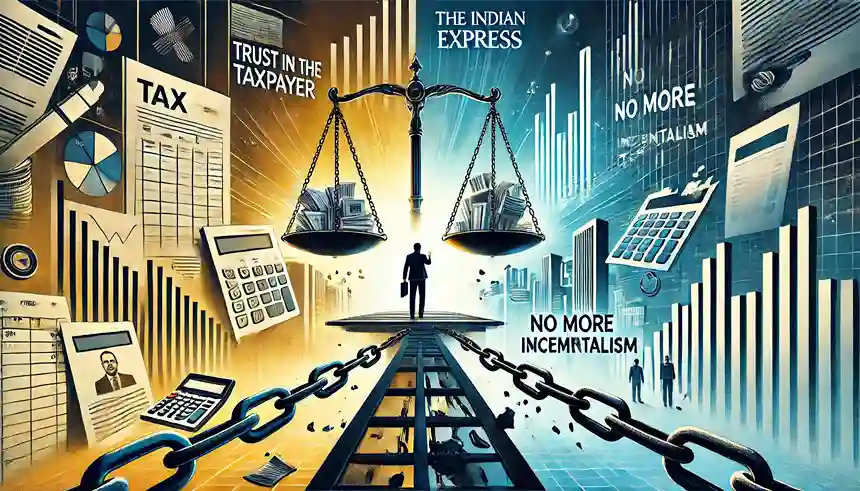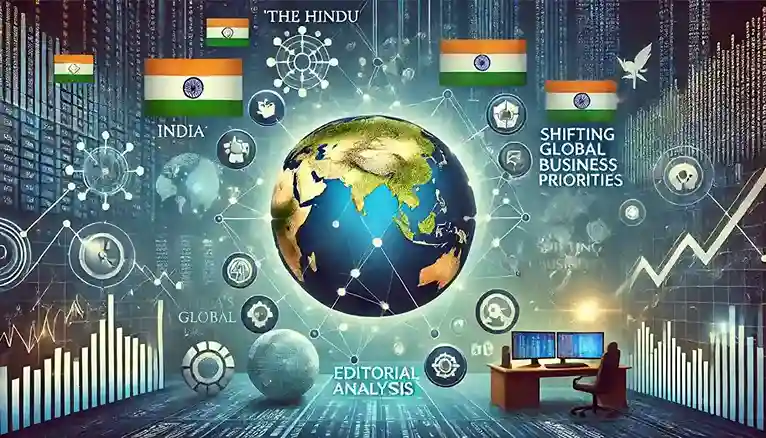Analysis of The Hindu Editorial 1: India’s choices in a world becoming bipolar again
Context
As the global geopolitical landscape once again takes on a bipolar form, India faces a delicate balancing act. The rising tensions between China and the United States place India in a precarious position—one that requires careful diplomatic navigation to avoid becoming a mere pawn in this power struggle.
Introduction: Diplomatic Uncertainty and a Renewed Hope
Recently, India’s National Security Adviser Ajit Doval met with Chinese Foreign Minister Wang Yi on the sidelines of the BRICS National Security Advisers’ meeting in St. Petersburg, Russia. This meeting sparked hopes that the strained relations between India and China, a tension that peaked after the deadly 2020 Galwan Valley conflict, could see improvement. Yet, at the same time, India’s relations with the United States have reached new heights, with Washington seeing India as a crucial partner in countering China’s growing influence in the Indo-Pacific region. The question that now looms is whether India is once again being pushed into making difficult choices in a bipolar global order.
The Complex U.S.-China Relationship
Although China and the U.S. are rival superpowers, their relationship is far more interconnected than that of the U.S. and the U.S.S.R. during the Cold War. These economic and social ties include:
- The U.S. being the largest foreign investor in China.
- China owning more U.S. Treasury bonds than any other nation.
- A significant number of Chinese students and tourists choosing the U.S. as their destination of choice.
This complex relationship—marked by rivalry yet underpinned by deep economic and social connections—demands a nuanced approach, making it distinct from the Cold War-era bipolarity.
- Analysis of The Indian Express Editorial – February 13, 2025

- Analysis of The Indian Express Editorial – February 12, 2025

- Analysis of The Indian Express Editorial – December 31, 2024

- Analysis of The Indian Express Editorial – December 19, 2024

- Analysis of The Indian Express Editorial – December 18, 2024

Cold War vs. Today’s Geopolitical Climate
The Cold War era was marked by the strict division of the world into U.S. and Soviet spheres, with each side drawing satellite states into its orbit. The rivalry between the two powers was sharpened by the threat of nuclear conflict and the “iron curtain” that divided East and West. However, today’s global order is vastly different:
- The end of the Cold War ushered in a period of U.S. global dominance, but this “unipolar moment” was relatively brief.
- The 2008 financial crisis marked the beginning of China’s economic ascent, with Beijing emerging as a key player on the global stage.
- China’s rise has been fueled largely by U.S. investment in its manufacturing sector, leading to a shift in the global balance of power.
China now challenges U.S. hegemony in multiple arenas, from economics to technology, yet this new form of rivalry is less rigidly ideological than the Cold War.
Sino-American Rivalry: A Different Kind of Competition
Unlike the Cold War, where the U.S. and the Soviet Union operated largely in isolation from one another, the U.S. and China are economically intertwined. China has become a central player in global supply chains, making its influence even greater than that of the U.S.S.R. during the Cold War. This economic interdependence has led analysts to describe the current rivalry not as a new Cold War, but rather as a form of “competitive coexistence.”
- The U.S. has shifted its rhetoric from “decoupling” from China to “de-risking,” recognizing that a complete severance of ties is neither practical nor desirable.
Military Parity and Proxy Wars
Another key distinction between the Cold War and today’s Sino-American rivalry is the nature of military competition:
- While the U.S. and the Soviet Union were nearly equal militarily, China’s military capabilities are rapidly approaching those of the U.S., particularly in naval and air power.
- Despite this, the two powers have so far avoided the proxy wars that were characteristic of the Cold War period.
- Experts predict that China’s military will continue to grow, but significant gaps remain between China and the U.S., at least until 2027.
- [PDF] “Arihant Computer Awareness Book 1” – Free Download
![[PDF] Arihant Computer Book.pdf” – Free Download for Competitive Exams](https://savepdf.in/wp-content/uploads/2025/04/PDF-Arihant-Computer-Book.pdf-–-Free-Download-for-Competitive-Exams-1040x650.webp)
- [PDF] The Pragmatic Programmer by David Thomas and Andrew Hunt

- [PDF] Structure and Interpretation of Computer Programs
![[PDF] Structure and Interpretation of Computer Programs](https://savepdf.in/wp-content/uploads/2024/12/PDF-Structure-and-Interpretation-of-Computer-Programs-1157x650.webp)
- [PDF] Computer Fundamentals by Anita Goel – Free Download
![[PDF] Computer Fundamentals by Anita Goel – Free Download](https://savepdf.in/wp-content/uploads/2024/11/Computer-FundameComputer-Fundamentals-by-Anita-GoelComputer-Fundamentals-by-Anita-Goelntals-by-Anita-Goel-1156x650.png)
- [PDF] – Mainframe Systems Programming: An Introduction – Download Now
![Mainframe Systems Programming: An Introduction – [PDF]](https://savepdf.in/wp-content/uploads/2024/10/PDF-–-Mainframe-Systems_20241004_162243_0000-1156x650.webp)
Ideology: A Minor Factor in Today’s Rivalry
During the Cold War, the U.S. sought to promote capitalism and liberal democracy as a counter to Soviet communism. However, the current U.S.-China rivalry is not driven by ideology in the same way. While American leaders sometimes frame the competition as a battle between democracy and autocracy, China’s main concern is securing global dominance, not spreading communism.
- Washington’s efforts, such as the Summit for Democracy, have done little to rally global support against China’s rise.
- Meanwhile, China dismisses such efforts as “Western-style democracy” that serves capitalist interests rather than ordinary citizens.
Russia’s Role in the New Bipolar World
Adding complexity to this rivalry is Russia, the successor state to the U.S.S.R., which plays a more subtle but still significant role in the U.S.-China dynamic. While Russia’s economy and military budget are much smaller than China’s, it remains a key player due to its natural resources and nuclear capabilities.
- Some analysts argue that the real bipolarity is between the U.S. and the China-Russia axis, with Russia playing a junior role to China.
- China’s support for Russia in the Ukraine conflict underscores this partnership, presenting new challenges for global stability.
The Indo-Pacific: A New Geopolitical Battleground
The rise of China and the shifting global power dynamics have led to the emergence of the Indo-Pacific as a critical theater of geopolitical competition. Three key developments characterize this new landscape:
- China’s Naval Ambitions: China seeks to build a blue-water navy, capable of projecting power far beyond its shores.
- India’s Role: India is positioned as a potential counterbalance to China in the region.
- U.S. Strategy: The U.S. is working to reshape alliances and build strategic partnerships in the Indo-Pacific as global power shifts from the West to the East.
Strategic Alliances: Quad and AUKUS
In response to China’s ambitions, new strategic alliances have formed in the Indo-Pacific:
- The Quad—a partnership between the U.S., India, Japan, and Australia—aims to promote a “free and open Indo-Pacific.”
- The AUKUS pact, involving the U.S., U.K., and Australia, is designed to bolster Australia’s naval capabilities through nuclear-powered submarines, further realigning geopolitical power in the region.
Conclusion: India’s Path Forward
As India navigates this new era of Sino-American rivalry, it faces both opportunities and challenges. India’s growing partnership with the U.S. and the Quad presents a chance to strengthen its position on the global stage. However, India must also remain vigilant about its own security, especially given its land-based tensions with China. By balancing economic engagement, military deterrence, and strategic alliances, India can safeguard its sovereignty and promote its interests in this complex global order.
- [PDF] Kiran SSC 10600+ General Awareness Book English
![[PDF] Kiran SSC General Awareness Book English](https://savepdf.in/wp-content/uploads/2024/12/PDF-Kiran-SSC-10600-General-Awareness-Book-English-1156x650.webp)
- [PDF] – Manorama Yearbook 2025: A Comprehensive Guide to Knowledge and Exam Success

- [PDF] Blackbook 25000+ GA English Medium
![[PDF] Blackbook 25000+ GA English Medium](https://savepdf.in/wp-content/uploads/2024/11/PDF-Blackbook-25000-GA-English-Medium-1156x650.webp)
- [PDF] Reasoning Made Easy – Download Now
![[PDF] Reasoning Made Easy](https://savepdf.in/wp-content/uploads/2024/11/Reasoning-Made-Easy-1156x650.webp)
- [PDF] Police Recruitment Challenger – Download Now
![[PDF] Police Recruitment Challenger](https://savepdf.in/wp-content/uploads/2024/11/Police-Recruitment-Challenger-1156x650.webp)
Analysis of The Hindu Editorial 2: Essential business priorities in a changing world
Context
As both advanced and emerging economies adapt to an evolving global landscape, the focus on inclusive growth and sustainable development is becoming more critical. To achieve this, businesses worldwide must take proactive steps, guided by key policy actions, to foster a more equitable and prosperous future for all.
Introduction: A Global Economy in Transition
The global economy has begun to stabilize after a period of turbulence, though geopolitical risks still loom large. The G-20 economies have shown varied growth trajectories—some exceeded expectations while others faced hurdles in the first quarter of this year. In this context, businesses now have the opportunity to seize emerging growth opportunities and ensure that development benefits are more widely shared.
The Role of the B-20 Process and Emerging Economies
Over the past three years, the B-20 process, driven by emerging economies, has initiated a transformative agenda for the Global South. With the baton set to pass to South Africa later this year, businesses from both advanced and developing countries have identified key priorities that will drive inclusive growth. However, to stay aligned with global challenges, businesses must not only adapt but also take bold action to remain competitive and relevant.
Focus on Inclusive Development
1. Equitable Growth as a Top Priority
In today’s world, promoting equitable growth is not just an ideal—it’s a necessity. Achieving this requires empowering workers through skill development and education, enabling them to adapt to ever-changing industry landscapes.
- Role of Businesses: Businesses can lead the charge by offering customized training and upskilling programs, particularly for underrepresented groups such as women. This can be done in collaboration with academic institutions to create curricula that reflect evolving industry needs.
2. Financial Inclusion and Diversity Policies
Inclusive financial policies have the power to transform economies. B-20 Brazil has emphasized the importance of financial access, along with diversity and inclusion, to enable economic participation for all.
- India’s Example: The success of India’s Unified Payments Interface (UPI) and the landmark Jan Dhan Yojana, which opened over 530 million bank accounts, provides a model for other countries. These programs demonstrate how financial inclusion at scale can drive economic growth and inspire similar initiatives globally.
3. Africa’s Growing Role in the Global Economy
With Africa’s inclusion in the G-20 during India’s presidency, a new world of opportunities has opened. Global businesses must recognize the potential of Africa’s young population and its rapid economic growth.
- Expanding Business in Africa: By increasing their presence in Africa, businesses can support the continent’s integration into global value chains while benefiting from its dynamic market.
| Priority Area | Key Actions for Businesses |
|---|---|
| Skill Development | Offer customized upskilling programs, especially for women |
| Financial Inclusion | Promote financial access and diversity through new policies |
| African Economic Engagement | Expand business operations and foster global integration |
Ensuring Food Security and Sustainability
1. Sustainable Food Systems
Food and nutrition security is a critical aspect of sustainability, especially as climate change and extreme weather events threaten global food supplies.
- Business’s Role: Companies can help secure the future of food by investing in sustainable agricultural technologies, reducing food waste, and ensuring equitable access to nutritious food. Collaboration with governments and international organizations is crucial to driving this agenda forward.
2. Technology in Agriculture
The adoption of digital tools and precision farming can revolutionize the agricultural sector, increasing efficiency while reducing environmental impacts.
| Sustainability Focus | Business Contribution |
|---|---|
| Sustainable Agriculture | Invest in technology and promote sustainable practices |
| Food Security | Collaborate to ensure equitable access to nutritious food |
Strengthening Resilient Global Trade
1. The Importance of Global Trade
A resilient global trade system is essential for economic growth. However, rising tariffs and national security concerns have created obstacles that hinder free trade.
- Supporting Fair Trade Practices: Businesses must advocate for the strengthening of institutions like the World Trade Organization (WTO) to ensure that unfair trade practices are addressed. Creating globally agreed-upon standards for environmental and industrial practices can also add clarity to trade policies.
2. Navigating Global Trade Complexities
Clear and interoperable taxonomies for environmental sustainability can help businesses better understand and adhere to trade regulations, ensuring that global commerce remains resilient and beneficial.
Embracing Digital Transformation and Innovation
1. AI and Innovation for the Common Good
The digital transformation, particularly the responsible use of Artificial Intelligence (AI), offers immense opportunities for solving global issues such as climate change and healthcare challenges.
- Engaging the Youth: Businesses should actively involve young innovators in addressing these issues by investing in social tech startups and creating platforms for collaborative research and development.
2. STEM Talent and Digital Platforms
To meet future challenges, businesses must commit to nurturing talent in Science, Technology, Engineering, and Mathematics (STEM). Corporations should also create digital platforms that encourage the development of new, impactful technologies.
Sustainability as a Core Business Mission
1. Net-Zero Transition
As the world races toward a net-zero future, businesses must align their operations with fair and sustainable climate policies. This transition is not only about reducing carbon emissions but also ensuring that the shift is equitable for small and medium enterprises (SMEs) as well.
- Renewable Energy and Circular Economy: By building renewable energy capacity and exploring biofuels and green hydrogen, businesses can take meaningful steps toward sustainability. Furthermore, adopting circular economy principles can help minimize waste and resource use in everyday operations.
Way Forward: Setting New Standards for Corporate Governance
As businesses strive to meet these global challenges, they must hold themselves to the highest standards of corporate governance. Ethical practices are essential for building trust between corporations, governments, and communities. In today’s interconnected world, this trust is foundational to achieving economic growth and fostering an environment conducive to business success.
| Focus Area | Key Business Initiatives |
|---|---|
| Digital Transformation | Leverage AI responsibly and invest in STEM talent |
| Corporate Governance | Prioritize ethical practices to build stakeholder trust |
Conclusion: A Collaborative Effort for Global Aspirations
The establishment of the B20 Global Institute, initiated under India’s leadership, aims to ensure that businesses remain competitive while aligning with key global policy suggestions. As successive G-20 presidencies contribute to this effort, the institute will focus on facilitating action across these crucial areas. The private sector’s active role in realizing the collective global aspirations of inclusive growth and sustainability will be vital in ensuring lasting success.

